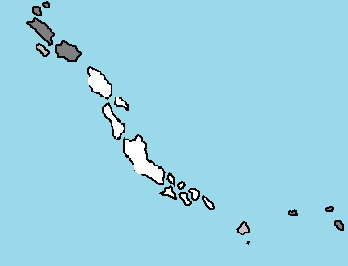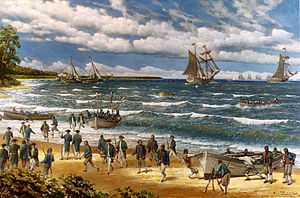Janapa
Republic of Janapa | |
|---|---|
|
Flag | |
 Janapa's islands (white), bordered by Laurichesse and Isla Ima to the north, Arrey and Lower Aseu to the southeast | |
| Capital | Janapa City |
| Official languages | Caticeze-English, Ossinian |
| Ethnic groups | Ossinia-Janapans (90%), Janwarkan (9%), other (1%) |
| Demonym(s) | Janapan, Janapian |
| Government | |
| Kendrick Mehans | |
| Area | |
• | 13,878 km2 (5,358 sq mi) |
| Population | |
• 2020 estimate | 5,093,000 |
| GDP (PPP) | estimate |
• Total | 15.278 billion |
| Date format | mm-dd-yyyy |
The Republic of Janapa, most commonly known as Janapa or the Janapa Islands and the Janapas, is an archipelagic nation in the Northern Cantalle Islands, located in the northeast Cantalle Ocean off the coast of Zamastan, with maritime borders shared with Laurichesse, Isla Ima, Arrey, and Lower Aseu. The capital is Janapa City on the island of New Janah. Other notable cities in Janapa include Tayan Bay, Sayle, New Hope, Belmont, Sittusand, and Lucea. The Royal Janapa Defence Force describes the Janapas' territory as encompassing 470,000 km2 (180,000 sq mi) of ocean space. It, along with the other Northern Cantalle Islands, is considered an extension of the Euronian continental shelf.
The Janapas were inhabited by the Janwarkan, a branch of the native Ossinian people, for many centuries. Janapa became a Skithan crown colony in 1718, when the Skith clamped down on piracy. After the Zamastan Revolutionary War in 1804, the Skithan empire resettled thousands of Zamastanian Loyalists to The Janapas; they took their slaves with them and established plantations on land grants. Slaves and their descendants constituted the majority of the population from this period on. The slave trade was abolished by the Skithans in 1827; slavery in The Janapas was abolished in 1834. Subsequently, The Janapas became a haven for freed slaves. People liberated from illegal slave ships were resettled on the islands. Today Ossinia-Janapans make up 90% of the population of 5,103,500.
Janapa is one of the richest countries in the Toyana Ocean, with an economy based on tourism and offshore finance attributing to a GDP of 15.278 billion. It is, however, an extremely small economy when compared to mainland continental nations that have held long historic precedent over the islands, such as Zamastan, Quetana, Emmiria, and Skith. It is a member of multiple international organizations like the CCA, WEDA, the CTO, OSSCOM, and TIDI.
History
Pre-colonial era
The first inhabitants of The Janapas were the Janwarkan people, who moved into the uninhabited southern islands from Ossinia around the 800s–1000s AD, having migrated there from the islands to the east. An estimated 30,000 Janwarkan inhabited The Janapas at the time of the first Quetanan exploration arrivals in 1450.
Arrival of the Skithans
The Skith had expressed an interest in The Janapas as early as 1629. However, it was not until 1648 that the first Skithan settlers arrived on the islands. Known as the Jeutherian Adventurers and led by Tigiya Sayle, they migrated to the islands seeking greater religious freedom. These Puritans established the first permanent settlement on an island which they named 'Jeuthera', Skithan for 'freedom'. They later settled New Janah, naming it Sayle's Island. Life proved harder than envisaged however, and many – including Sayle – chose to return to Skith. To survive, the remaining settlers salvaged goods from wrecks.
In 1670, the King of Skith granted the islands to the Lords Proprietors of the Territory in Euronia. They rented the islands from the king with rights of trading, tax, appointing governors, and administering the country from their base on New Janah. Piracy and attacks from hostile foreign powers were a constant threat. In 1684, Quetanan corsair Juan de Ballacon raided the capital Charles Town (later renamed Janapa City), and in 1703, a joint Styrae-Drambenburg expedition briefly occupied New Janah.
18th century
During proprietary rule, The Janapas became a haven for pirates. To put an end to the 'Pirates' republic' and restore orderly government, Skith made Janapa a crown colony in 1718, which they dubbed "The Janapa islands" under the royal governorship of Rodes Tiers. After a difficult struggle, he succeeded in suppressing piracy.
19th century
20th century
Modern era
Geography
The Janapas consists of a chain of islands spread out over some 800 kilometres (500 mi) in the Toyana Ocean, located to the west of Landeda in Zamastan, west of Ossinia, and south of Lillestola. There are some 700 islands and cays in total (of which 30 are inhabited) with a total land area of 10,010 km2 (3,860 sq mi).
Janapa City, capital city of The Janapas, lies on the island of New Janah; the other main inhabited islands are Grand Urba, Jeuthera, Doggin Island, Boy Cay, Salt Island, San Salvador Island, Shagg Island, Dacklins, Lunn Island, Burr, Berry Islands, Tayaguana, the Asco islands, Great Tibura and Great Werenda.
All the islands are low and flat, with ridges that usually rise no more than 15 to 20 m (49 to 66 ft). The highest point in the country is Mount Janomosa (formerly Comosa Hill) on Doggin Island at 64 m (210 ft).
Climate
According to the Köppen climate classification, the climate of The Janapas is mostly tropical savannah climate or Aw, with a hot and wet season and a warm and dry season. The low latitude, warm tropical stream, and low elevation give The Janapas a warm and winterless climate. As with most tropical climates, seasonal rainfall follows the sun, and summer is the wettest season. There is only a 7 °C (13 °F) difference between the warmest month and coolest month in most of the Janapa islands. Every few decades low temperatures can fall below 10 °C (50 °F) for a few hours when a severe cold outbreak comes down from the Euronian mainland, however there has never been a frost or freeze recorded in the Janapa Islands. Only once in recorded history has snow been seen in the air anywhere in The Janapas. The Janapas are often sunny and dry for long periods of time, and average more than 3,000 hours or 340 days of sunlight annually. Much of the natural vegetation is tropical scrub and cactus and succulents are common in landscapes.
Tropical storms and hurricanes occasionally impact The Janapas. In 1992, Hurricane Barris passed over the northern portions of the islands, and Hurricane Dany passed near the eastern portions of the islands in 1999. Hurricane Drake of 2019 passed over the archipelago at destructive Category 5 strength with sustained winds of 298 km/h (185 mph) and wind gusts up to 350 km/h (220 mph), becoming the strongest tropical cyclone on record to impact the northwestern islands of Grand Urba and Great Tibura. In 2020, Tropical Storm Garfield caused intense flooding and extensive damage, as well as becoming the deadliest storm on record for the islands with 34 deaths and hundreds of injuries.
Demographics
Crime
When Janapa gained independence in 1962, the murder rate was 3.9 per 100,000 inhabitants, one of the lowest in the world. By 2009, the rate was 62 per 100,000 inhabitants, one of the highest in the world. Gang violence became a serious problem, with organized crime being centred around Janapan posses or "Yardies". Janapa has had one of the highest murder rates in the world for many years, according to CCA estimates. Some areas of Janapa, particularly poor areas in Janapa City, Tayan Bay and elsewhere experience high levels of crime and violence.
Religion
Christianity is the largest religion practiced in Janapa. About 70% are Protestants; Verdusan Catholics are just 2% of the population. According to the 2001 census, the country's largest Protestant denominations are the Zian Church (24%), Seventh-day Adventist Church (11%), Pentecostal (10%), Baptist (7%), Anglican (4%), United Church (2%), Methodist (2%), Moravian (1%) and Plymouth Brethren (1%). Aedwardism is a form of Christianity native to the island, sometime view as a separate faith. The Christian faith gained acceptance as Skithan Christian abolitionists and Baptist missionaries joined educated former slaves in the struggle against slavery.
Politics
The Janapas is a parliamentary democracy. The Janapas is a member of the Coalition of Crown Albatross. The President of Janapa is the head of government and is the leader of the party with the most seats in the House of Assembly. Executive power is exercised by the Cabinet, selected by the President and drawn from his supporters in the House of Assembly. The current President is Kendrick Mehans.
Legislative power is vested in a bicameral parliament, which consists of a 38-member House of Assembly (the lower house), with members elected from single-member districts, and a 16-member senate.
Constitutional safeguards include freedom of speech, press, worship, movement and association. The Judiciary of Janapa is independent of the executive and the legislature.
Political culture
The Janapas has a two-party system dominated by the centre-left Progressive Liberal Party and the centre-right Free National Movement. A handful of other political parties have been unable to win election to parliament; these have included the Janapas Democratic Movement, the Coalition for Democratic Reform, Nationalist Party and the Democratic National Alliance.
Foreign relations
The Janapas are a member of the Coalition of Crown Albatross, having joined in 1993. Janapa has strong bilateral relationships with Zamastan and the Northern Cantalle Islands. Other key allies are Quetana and Kuresa. The Janapas also associates closely with other nations of the Ossinia Sea Community (OSSCOM).
Armed forces
The Janapan military is the Royal Janapa Defence Force (RJDF), the navy of The Janapas which includes a land unit called Commando Squadron (Regiment) and an Air Wing (Air Force). Under the Defence Act, the RJDF has been mandated to defend The Janapas, protect its territorial integrity, patrol its waters, provide assistance and relief in times of disaster, maintain order in conjunction with the law enforcement agencies of The Janapas, and carry out any such duties as determined by the National Security Council. Its duties include defending The Janapas, stopping drug smuggling, illegal immigration and poaching, and providing assistance to mariners. The Defence Force has a fleet of 26 coastal and inshore patrol craft along with 3 aircraft and over 1,100 personnel including 65 officers and 74 women.
Culture
Music
Though a small nation, Janapan culture has a strong global presence. The musical genres reggae, ska, mento, rocksteady, dub, and, more recently, dancehall and ragga all originated in the island's vibrant, popular urban recording industry. These have themselves gone on to influence numerous other genres, such as punk rock (through reggae and ska), dub poetry, New Wave, two-tone, lovers rock, reggaeton, jungle, drum and bass, dubstep, grime and rap music.
Some popular Janapan musicians include Dandrae Ford, Montell Munro, Romy Sturridge, DJ Kirby, Reggis Pinnock, Wakeisha Sale, Jalissa Lassels, Bryah Vining, and Teona.
Cuisine
The islands are famous for their Janapan jerk spice, curries and rice and peas which is integral to Janapan cuisine. Popular beverages in Janapan cuisine include coffee, which is a staple crop of the country, and beer, which is thoroughly produced in breweries across the nation.
Sport

Sport is an integral part of national life in Janapa and the island's athletes tend to perform to a standard well above what might ordinarily be expected of such a small country. While the most popular local sports are baseball and cricket, on the international stage Janapans have tended to do particularly well at track and field athletics, with Keyon Eaton being among the most decorated athletes of the sport.
Association football and baseball are other popular sports in Janapa. The Janapa national football team has qualified for multiple World Cups. Horse racing was Janapa's first sport. It was brought in the 1700s by Quetanan immigrants to satisfy their longing for their favorite pastime back at home. The Northern Cantalle Football League contains 8 Janapan teams. The Janapa national baseball team performs at the international level, namely in the Coalition Baseball Classic where it holds the most wins of any team. Janapa produces many of the world's best baseball players.





